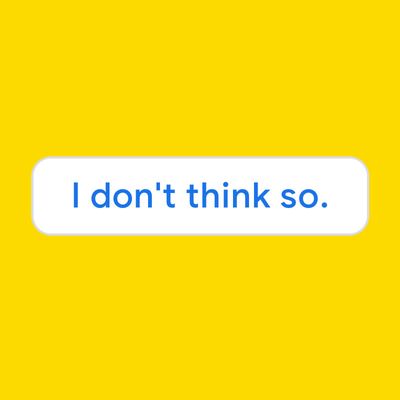
The most recognizable feature of Gmail’s newly rolled-out redesign is the so-called smart reply, wherein bots offer three one-click responses to each mail message. Say your email contains the words “you free for lunch?” The autoreplies Gmail presents will be something like “Sure!” and “Yes!” and “Looking forward to it!” The idea, especially on a small, one-hand phone screen, is that you can tap and send using one thumb, without typing. It’s not clear just how many of these prewritten options there are, or how sophisticated the machine learning behind them is. The AI is not yet sharp enough to offer genuinely useful responses like “Please, for the love of Christ, stop sending me these offers to buy those sandals whose ad I clicked on last month” or emotionally honest ones like “Hey, it would be wonderful if someone in our group cancels our drinks tonight because I would rather stay home and order dan dan noodles while watching Succession.” Until then, we’re stuck with the few dozen simple responses that appear regularly. Some are better than others. Shall we rank? Ok, sounds good!
20. “No worries, thanks for the heads up!”
A disaster. First of all, it’s a seven-word phrase that contains two grammatical errors (a comma splice and the missing hyphen in “heads-up”). And then the phrase “no worries!” injects a note of concern where there was none. Should I in fact be worried? Should I have been worried? The only possible use of this response is when a frantic employee sends an email to the boss about a potential problem, and the boss wants to knock down his or her anxiety a little. I’m not projecting here.
19. “You are so welcome!”
That “so” in the middle is what dooms this one. It’s unusably chirpy mean, really underminer stuff. You use this when someone thanks you for getting the T-shirts in time for rush week. Comes with an unspoken “[asshole!]” at the end. In the South, the equivalent would be “Bless your heart.”
18. “Thank you, you too!”
What does this phrase even mean? Stare at it more, and you’ll understand it less with every passing minute. Plus it’s another goddamn comma-splice run-on sentence. Get these bots a copy of Words Into Type already.
17. “It was great seeing you too!”
The hell with this. Either you didn’t actually think it was great (in which case, sure, send this, why not), or you did, in fact, think it was great (in which case you should probably write something a little more heartfelt and less anodyne).
16. “Love it!”
No editor will ever use this.
15. “Have a great weekend too!”
Isn’t “Have a great weekend” perfectly and explicitly the way you end an email exchange? It all but defines the you-don’t-have-to-respond-to-this genre of messages. Why the hell would you write back?
14. “Cool, thanks!”
“Thanks!” is meaningful. “Cool, thanks!” means … what, exactly? I like what you said, and thank you for saying it? Literally a phrase I have never spoken or typed. But Google will type it for me!
13. & 12. “Yes, he is,” and “No, he’s not.”
Two observations here: The internal commas make the vibe curiously old-fashioned, stilted, almost Victorian. And the flat period, replacing the chirpy bang, inadvertently comes off as relatively dead-eyed, almost angry. “Yes, he is. The man you just made fun of is indeed the same one whose blood I wear in a vial around my neck. Care to continue?”
11. “It was my pleasure!”
Amid all the “Cool!” and “Very cool!” replies appears this oddly formal one. Useful for the 49-year-old mid-level manager who’s said yes to his or her third “informational interview” in a week. I’m not projecting here.
10. “I’ll ask.”
This one has potential. No exclamation point of fake enthusiasm here; what it means is “if it were up to me I’d tell you to go to hell, but since it is not up to me, I’m happy to deflect responsibility for your coming rejection onto someone else. Either way, don’t get your hopes up.”
9. “I’ll look into it.”
See “I’ll ask,” above. This is the version for graduate-level players only. (The Ph.D. version reads “I’ll look into it …” with the hanging ellipsis.)
8. “Looking forward to it!”
Can’t quite decide about this one because I am so rarely looking forward to anything that comes by email. Maybe someone else is. I will reserve judgment for now.
7. & 6. “So true!” and “I agree!”
Not as useful as they might have been a few years ago, when heartwarming Upworthy videos were more popular. Maybe they’ll come back into relevance around the election, when you start getting more of those lefty chain emails from your great-uncle in Vermont, the ones that end with the “Coexist” logo.
5. “Got it!”
Could be something to send after you get a sensitive document and you want to acknowledge it. “Got it — thanks,” sans exclamation point, with em-dash, would be vastly better. Either way, it’s the text equivalent of the return receipt. Allowable under some circumstances.
4. “I don’t think so.”
Every editor can use this. Also, if they sold it on a T-shirt, I’d buy it.
3. “It is!”
Situationally useful. “We’d said 1 p.m. — is this meeting still happening?” And it’s tonally appropriate there, too. Not bad.
2. “Thanks!”
The Dasani option in the gas-station soda machine. Everything else is terrible for you; this is fine.
1. “Why?”
The best idea Google has ever had. I will consider sending this reply to every message I ever receive, forever.






























